Light Communications for Wireless Local Area Networking
Nikola Serafimovski, pureLiFi, Ronan Lacroix, Deutsche Telecom, Micheline Perrufel, Orange, Sylvain Leroux,Orange, Simon Clement, Liberty Global, Nirlay Kundu, Verizon, Dominique Chiaroni, Nokia, Gaurav Patwardhan, Hewlett Packard Enterprise, Andrew Myles, Cisco, Christophe Jurczak, Lucibel, Marc Fleschen, Zero.1, Marty Ragusky, VLNComm, Volker Jungnickel, HHI, Dimitri Ktenas, CEA Leti, Harald Haas, University of Edinburgh
IEEE 5G Tech Focus: Volume 2, Number 2, May 2018
Why?
Setting the Scene
We live in an increasingly connected world where the spectrum for wireless communications must service an exponentially growing demand for wireless data.
The demand for mobile communications is increasing at over 50% per year according to the Cisco Visual Networking Index. Indeed, by 2021 more than half of 17 billion connected devices will be mobile, 65% of the IP traffic will be from mobile devices, 80% of the internet traffic will be video requiring high-speed wireless at an average speed of 20 Mbps. This demand is expected to increase as the Internet of Things (IoT) becomes a reality, and the number of connected devices grows from 5 billion to over 20 billion by 2020. Indeed, in 2017 for the first time, more objects were connected than human beings on Earth, with 8.38 billion connected devices compared to 7.5 billion humans (source Gartner 2017). Unsurprisingly, in 2016, over 50% of all wireless data went through a Wi-Fi access point. Figure 1 shows the historical and predicted demand for wireless data, pointing clearly to the inevitably growing shortfall in available wireless capacity over the years.
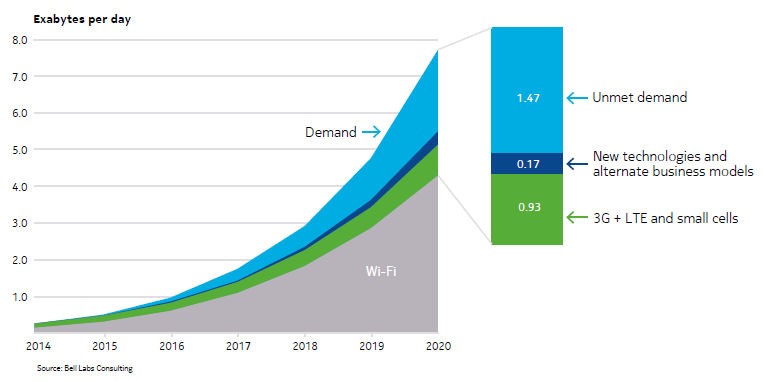
Figure 1: Historical and predicted demand/supply for wireless data. Source: http://telecoms.com/471823/nokia-bell-labs-research-forecasts-substantial-2020-mobile-capacity-shortfall/
This results in a need for a continued increase in capacity of wireless networks, which depends directly on the availability of additional unlicensed spectrum, the cost-effective deployment of the connectivity infrastructure and the increased densification of wireless access points. Indeed, over the past 60 years, the capacity of wireless networks has increased by over 1,000,000 times between 1955 and 2011, largely following Cooper’s Law where the data rate available to a wireless device doubles roughly every 30 months. It is cell densification that is responsible for over 1600 times of this growth, as shown in Figure 2.
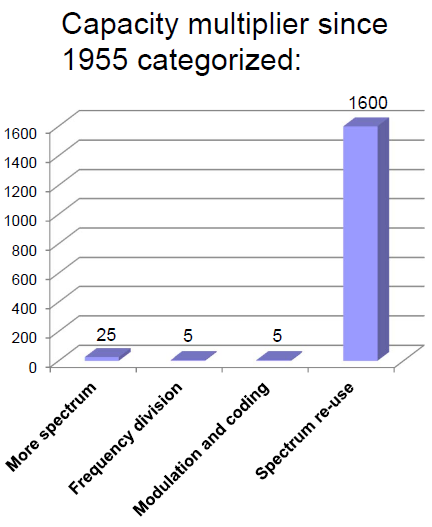
Figure 2: Key and contributing factors to the growth of wireless capacity from 1955 until 2011. The continued growth in wireless network capacity must come from smaller cells. Graphical representation of the findings: http://www.arraycomm.com/technology/coopers-law/
Despite the significant increase in cell densification, there is still a need for more spectrum. A recent study by the Wi-Fi Alliance has acknowledged the imminent need for more unlicensed spectrum, where it has identified:
- “Between 500 MHz and 1 GHz of additional spectrum in various world regions may be needed to support expected growth in Wi-Fi by 2020;
- If demand for Wi-Fi exceeds expected growth, then between 1.3 GHz and 1.8 GHz more spectrum may be required by 2025; and
- Wi-Fi spectrum needs to be sufficiently contiguous to support 160 MHz wide channels, which are required to support a growing number of bandwidth-intensive applications and to allow maximum Wi-Fi benefits to be attained.”
There are multiple solutions that can provide an increase in the available spectrum. As an example, WiGig solutions, defined in IEEE 802.11ad and being revised in IEEE 802.11ay that operate in the 60 GHz spectrum have access to around 14 GHz of bandwidth in the USA. However, WiGig and other mm-wave RF solutions all exhibit similar challenges. First, ICT (Information and Communication Technology) has gone through a radical transformation driven by efforts to reduce the carbon footprint. To achieve the required data densities at the same or lower power (data rate per meter squared), Wi-Fi/WiGig solutions implement beamforming. Beamforming requires multiple antennas with individual phase shifters. From the technical side, digital beamforming is preferable but it increases hardware complexity, power consumption and cost. Current designs are merely based on wideband analogue phase shifters being inappropriate in severe multipath propagation environments.
While it is expected that current technology problems can be overcome in the future, it is vital to consider further technologies probably leading to even smaller cells. Therefore, remember that RF is just one part of the electromagnetic spectrum and that the light along with the infrared spectrum has, for the most part, been underutilised for wireless communications. The visible light spectrum alone stretches from approximately 430 THz to 770 THz, which means that there is potentially more than 1000x the bandwidth of the entire RF spectrum of approx. 300 GHz. Both the visible light spectrum and the infrared spectrum are globally unlicensed. Light Communications (LC) devices are promising to make use of this previously untapped spectrum.
The applications for LC are limitless. Anywhere solid state lights, e.g., LED lights, are installed to provide illumination, there can also be high speed wireless data communications.
The success of LED lighting has been nothing less than earth shattering over the last 10 years. Common LED bulbs today consume 85% less energy than their incandescent counterparts and their deployment is poised to have a massive impact on the energy mix, with lighting accounting currently for as much as 15% of global electricity consumption and 5% of worldwide greenhouse gas emissions.
Costs have been slashed down through improvements in manufacturing and higher wall-plug efficiency. Costs per LED bulb remain higher than for incandescent and fluorescent technologies but a much longer lifespan up to 25,000 hours and energy savings make the cost per lumen much more competitive.
As a consequence, the LED lighting market share is already 40-50% (depending on the geography) and 70% of a global $100bn general lighting market will stem from LED shipments (lamps and luminaires) as early as 2020. In the US alone, LED installed stock is expected to grow from 6% in 2016 to close to 60% in 2025 and 90% in 2035.
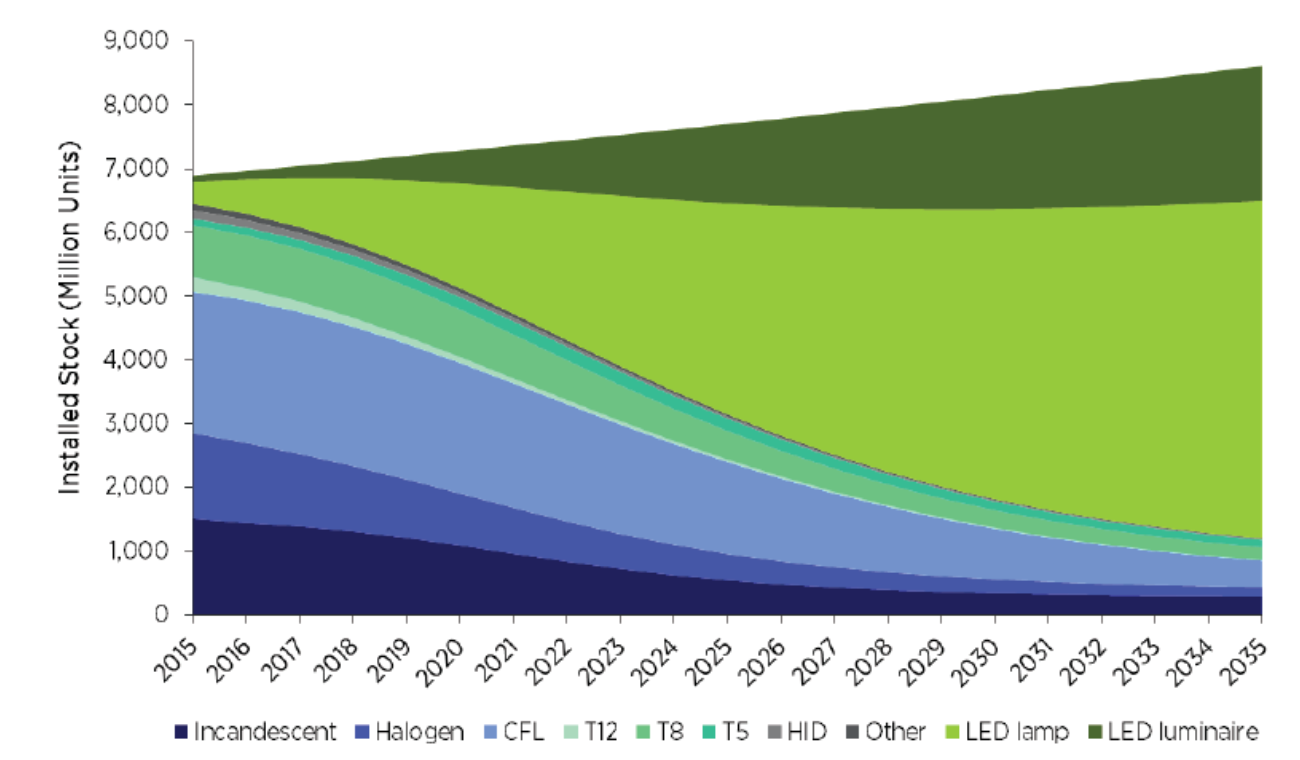
Figure 3: US lighting service forecast 2015 to 2025, Note: CFL = compact fluorescent light; HID = high intensity discharge. Source: US Department of Energy (2016)
Today, there are real life applications and benefits for implementing LC, examples of which are:
- Indoor Positioning – Because of the confined nature of light propagation in indoor environments, “indoor positioning” using LC is promising to deliver a variety of location-based services to networked wireless devices.
- Secure Communications – Since light does not pass through opaque materials, it can offer a secure communications channel created by the virtue of its propagation characteristics which can be user-controlled in case of visible light.
- RF-restricted environments – LC provides wireless data connectivity in environments such as petrochemical plants, hospitals, manufacturing plants, nuclear power generating stations, underground mines, underwater etc, where the use of RF is not wanted, not secure or actually impossible.
Considering that LED lighting will eventually become ubiquitous, the stage is set to transform lighting into a backbone for information.
What?
There are multiple technologies and concepts that use light for communications. Needless to say that the use of light is indispensable in worldwide optical fiber communication networks forming the backbone of the Internet. But light can also be used for wireless communication. As a simple example, the Infrared (IR) communications between a remote control and a television can be considered as light communications with very low data rate. Similarly, providing gigabit per second connectivity between buildings with dedicated free-space optical (FSO) links, most frequently using IR light, is another form of light communications with very high data rate, and it is essential to identify the relevant use-cases and differentiate the appropriate technologies enabling them.
The wider category of all technologies using the light spectrum for wireless communications is also often referred to as Optical Wireless Communications (OWC). In this context, there are broadly three different categories of OWC technologies:
- Free-space Optics (FSO),
- Optical Camera Communications (OCC), and
- LiFi
Free-space Optics has been used extensively to establish point to point communications over long distances, largely serving use-cases around wireless backhauling for urban areas, as a fiber replacement and will not be the point of focus here. Instead, we try to provide some clarity around the differences between OCC and LiFi, as these technologies are frequently confused.
Defining OCC
OCC uses the visible and near infrared spectrum for one-directional (simplex) communications at very low data rates (few bit/s to kbit/s) in a broadcast manner. The illumination LEDs produce fixed codes that are embodied in the light and can be used by OCC receivers. Due to the lack of a return channel, however, there is no inter-cell mobility support, i.e., no handover or roaming.
In general, the energy used for illumination can be used to provide this broadcast signal consistently, i.e., as long as the light is turned on. OCC could be used to provide accurate indoor positioning and limited amounts of information similar to how the Global Positioning System (GPS) is used to offer positioning in outdoor scenarios. Therefore, OCC can serve substantially similar use-cases as GPS, except it is operating in indoor environments.
OCC could be combined with RF technologies like 4G/5G, Wi-Fi, Bluetooth and more to provide a comprehensive location-based services proposition, offering sub-meter indoor precision. These systems have already been tested and effectively deployed to offer operational improvements for retail chains, shopping centers and even large office spaces and venues.
Defining LiFi
LiFi is defined as an optical wireless broadband access technology that uses the visible and infrared light spectrum to provide bi-directional (transmit and receive) capability. It is able to support uplink and downlink in a point-to-point or point-to-multipoint topology and provide multiuser access in this way. It has been demonstrated that LiFi can offer mobility support for both intra-cell and inter-cell movement link adaptation and handover. There are two principal version of handover:
- Horizontal handover– the ability to maintain a data connection to the network as a user moves from once cell to another using the same communications technology, like 4G, Wi-Fi or LiFi; and
- Vertical handover – the ability to maintain a data connection to the network as a user changes the principle radio access technology, i.e., moving from 4G to Wi-Fi or from Wi-Fi to LiFi.
The LiFi infrastructure comprises of multiple LED light bulbs that form a wireless communication network, offering a substantially similar user experience to other wireless communication technologies such as Wi-Fi (except using the light spectrum) though horizontal handover. In the future, LiFi could be developed to offer interoperability with Wi-Fi, 4G or other radio frequency (RF) systems where a user can be “opportunistically”, even concurrently, connected to LiFi and other RF to offer the best user experience.
LiFi is unique in that the same light energy used for illumination is also used for broadband data communication. It is a platform technology with the potential to complement and extend existing capabilities of RF technologies. LiFi provides a high-speed, secure, dense and reliable wireless network for enterprise and home environments and acts as an enabler for smart buildings, intelligent transport and smart cities.
How?
Understanding LiFi Technology
The term LiFi was coined by Professor Harald Haas, during a Ted Global Talk in 2011 where he demonstrated LiFi to a worldwide audience for the first time. LiFi extends the concept of visible light communication (VLC) (where even smoke signals can be considered as early forms of VLC) to achieve, specifically:
- high speed;
- bi-directional; and
- fully networked
optical wireless communications. In areas covered by networked ambient lights, the LiFi system supports random user locations. A LiFi system is composed of multiple small cells, also referred to as a LiFi attocell network since the cell sizes have radii of a few meters or less. Therefore, LiFi not only benefits from additional free spectrum, but it also takes the small cell concept to new levels because the light spectrum can and is reused more frequently compared to current mobile radio systems. As a consequence, a higher network capacity can be achieved.
Figure 4 illustrates the key parameters which define LiFi. LiFi transmission speed is in the 10Mbps-1Gbps range with LED lighting and can reach more than 5Gbps with new generations of Solid State Lighting devices.

Figure 4: Broad system parameters which define LiFi. Duplex mode refers to communication system where two connected parties or devices that can communicate with one another in both directions. There are two types of duplex communication systems: full-duplex (FDX) and half-duplex (HDX). In a full-duplex system, both parties can communicate with each other simultaneously on the same time and frequency resources. In a half-duplex system, each party can communicate with the other but not simultaneously; the communication is one direction at a time either in time or frequency. The dashed red-line outlines that LiFi systems are capable of FDX communications but also frequently use HDX communications.
LiFi Networking
Figure 5 illustrates the concept of a LiFi attocell network. The room is lit by a number of light fixtures, which provide illumination and an optical access point (AP) to users within the illumination pattern of the light. The illumination can be modulated at high rates, imperceptible to the human eye and providing an optical downlink. An optical uplink is implemented by using a transmitter on the user equipment (UE), often using an IR source (so it is invisible to the user), and a receiver close to the light fixture. Each of these light fixtures, acting as wireless LiFi APs, creates an extremely small optical cell (an attocell), which is available in addition to the RF coverage in the room. Therefore, LiFi has great potential to contribute in solving the difficult problem of indoor wireless coverage, which is particularly important as more than 80% or the wireless traffic is consumed indoors.
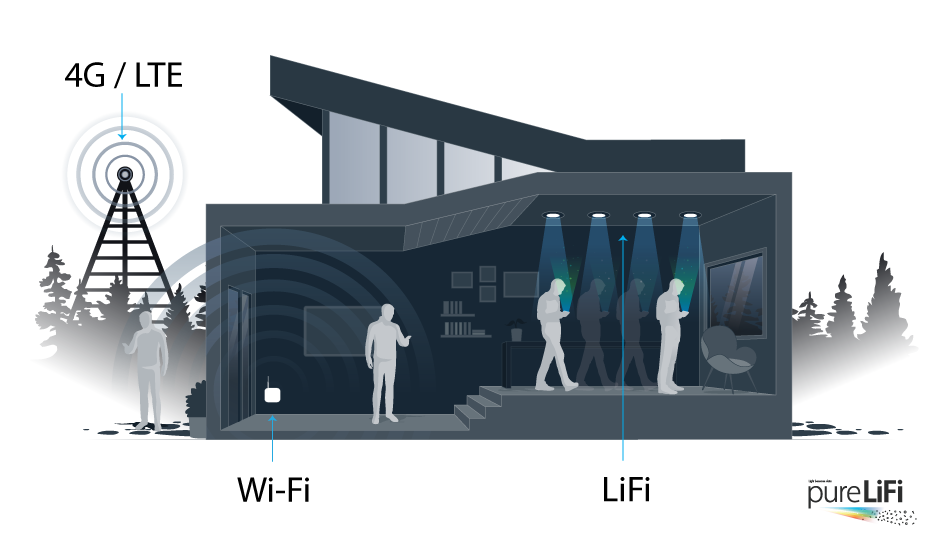
Figure 5: The concept of LiFi attocell networks applied to indoor wireless networking as part of a heterogeneous network
Increasing the density of wireless APs, however, also impacts the cost of the associated backbone. Fortunately, power and data can be provided to each light fixture using a number of different techniques, including power over Ethernet (PoE) and powerline communication (PLC). Individually both PoE and PLC have benefits and drawbacks, but taken together they could cover a wide array of use-cases in current buildings. In addition, these developments and their integration into the overall building systems are being driven by two other macro-trends. On the one hand, the increasing interest in connected Smart Building technologies which is making use of both existing and new infrastructure provides massive potential in order to provide energy savings but also to gain a better understanding of how buildings are used thus increasing both comfort and efficiency of building owners and users. On the other hand is the ongoing LED lighting revolution, where we are seeing conventional light fixtures and lighting infrastructure investments being replaced by modern LED fixtures. The combination of these trends provides a unique opportunity for the deployment of LiFi access points.
In cellular networks, dense spatial reuse of the wireless resources is used to achieve very high data density - bits per second per square meter (bps/m2). However, the links using the same channel in adjacent cells interfere with each other, which is known as co-channel interference (CCI). Figure 6 illustrates CCI in an optical attocell network
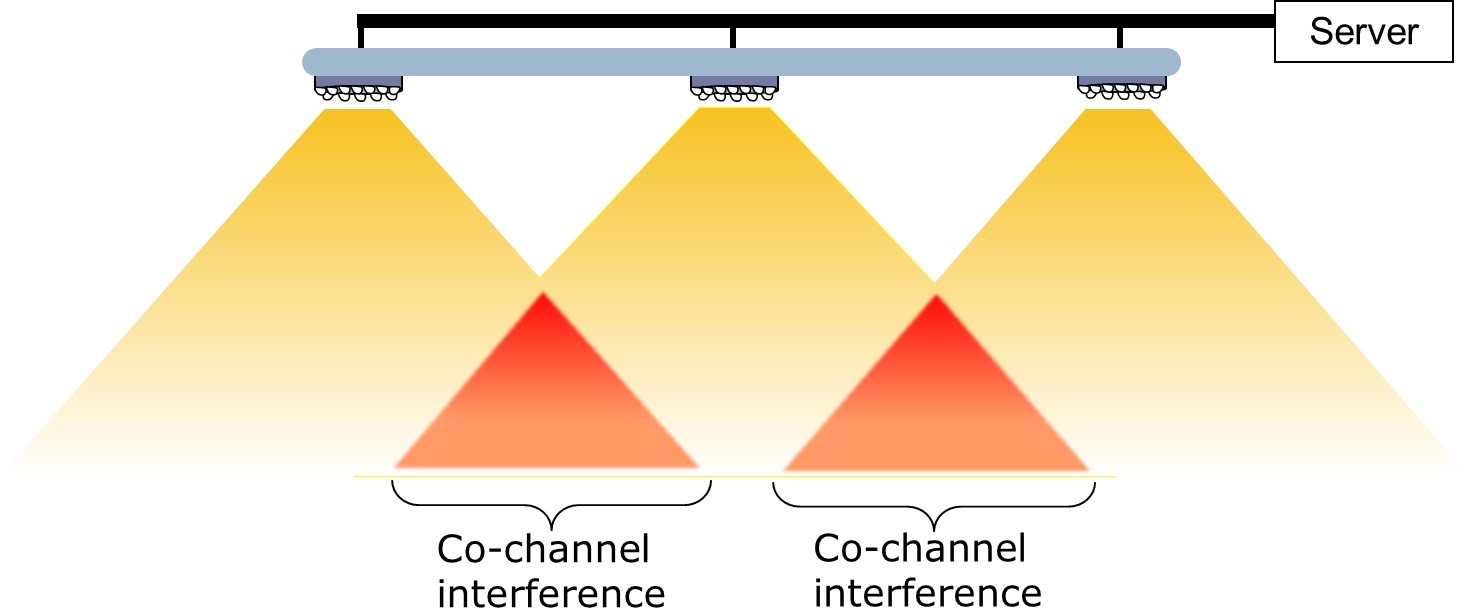
Figure 6: CCI occurs in the region where the same light spectrum of neighboring APs overlaps, and when these APs use the same modulation bandwidth for data encoding.
The move from point to point links to full wireless networks based on light poses several challenges. Within each cell, there can be a number of users and therefore a sophisticated medium access scheme is required. The provision of an uplink can also require a different approach from the downlink due to limited power consumption. Indeed, depending on the wireless service, uplink and downlink traffic can be symmetric or asymmetric. Asymmetric traffic provides opportunities for mechanisms that result in improved energy efficiency.

Figure 7: A room of size 2.5 m × 5 m is equipped with two LiFi luminaires installed at 3 m height pointing vertically downwards. The LiFi luminaires are illustrated by two blue squares in subplot (a). Both luminaires use the same visible light spectrum to transmit independent information. Vertically upwards pointing receivers at 0.75 m desk height are assumed. The illuminance at desk height is illustrated in subplot (b). The resulting SINR assuming a receiver FoV of 45◦ is depicted in subplot (c).
LiFi attocell networks can provide extra capacity without interference to RF networks that may already exist, and therefore have the potential to augment 5G cellular systems in a cost-effective manner. Figure 7 (b) shows the resulting illuminance at desk height of 0.75 m, when the luminaries are mounted at a ceiling height of 3 m. In the particular example, the lights are placed such that within the plane at desk height, 90% of the area achieves an illuminance of 400 lux based on a typical illumination requirement. Figure 7 (c) depicts the resulting signal-to-interference-plus-noise ratio (SINR). The region where the light cones overlap will be subject to strong CCI if the same wireless resource is used in both cells, and the SINR drops significantly. It is interesting to note that the SINR can vary as much as 30 dB within a few centimeters. The same graph suggests that the peak SINR could be in the order of 50 dB, which is two to three orders of magnitude higher than in RF based mobile systems. Note that the peak SNR in RF systems is due to interference from backwards-radiating side-lobes of antennas.
The considerations here do not account for the presence of diffused light, which is reflected from surrounding objects. The diffused light may be 20-30 dB below the signal coming from the direct line-of-sight. Without interference management, the achievable data rate would strongly depend on the network layout, the location of the receiver and its field of view (FoV). Similar to mobile radio, sophisticated interference mitigation techniques are required to ensure that a LiFi device can achieve a high SINR in the region with strong CCI. Indeed, a fundamental solution is coordinated multiple point (CoMP) in which geographically separated transmission points coordinate their transmissions to a terminal such that they combine constructively at the receiver and interference combines destructively at the same time. In this way, any inter-cell interference is avoided and the spectral efficiency of the system is improved both on average and at the edges between the cells. While this is an interesting research topic, LiFi networks can initially be deployed easily by using much simpler interference management techniques similar to current mobile networks. Performance can then be improved if complexity and overhead are increased.
LiFi will have a catalytic effect for the convergence of two major industries: i) the wireless communications industry and ii) the lighting industry. With an accelerating pace of penetration in the lighting market, LEDs are providing the opportunity of a better value proposition with increased cost/energy savings and open new business opportunities for manufacturers and financiers. Indeed, lighting control systems are greatly expanding the functions that can be performed by a luminaire, making lighting a central part of the Smart Building, Smart City, IoT and Edge concepts. New business models, such as 3rd party ownership of the lighting infrastructure, are already emerging. LiFi builds on these systems and concepts to satisfy a growing need of our society beyond illumination – wireless communications. The combination of these innovative concepts with LiFi will, therefore, provide a business model driven ‘pull’ for the lighting industry to enter what has traditionally been an ICT market. In the wireless industry, and in the broader context of 5G and indoor environments – where the majority of usages and demand originates – Heterogenous Networks will provide an improved quality of service and coverage. A hybrid LiFi and RF system would improve indoor connectivity and capacity by offering to off-load the traffic. Indeed, LiFi has the potential to open additional unlicensed spectrum and facilitate cost-effective deployment of extremely dense indoor networks, both essential to reducing the required investment for the next generation of wireless connectivity. However, an important prerequisite for the large-scale adoption of LiFi technology is the availability of standards. In this context, efforts have started in IEEE 802.11 to standardize LiFi as another physical layer in the IEEE 802.11 wireless local area networking group.

Figure 8: The transition from cm-wave to mm-wave is already happening in 5G. The paradigm shift that LiFi introduces is the move from cm-wave cellular communication to nm-wave cellular communication. Clearly, LiFi is complementary to RF, and adds substantial capacity to our wireless networks which are increasingly suffering from the RF spectrum crunch
Who?
The successful mass market deployment of LiFi will require further developments to reduce, costs, energy consumption and continued technology miniaturization. Critically, it will need a common technical standard and a comprehensive ecosystem (a market body) that will drive forward the ubiquitous adoption of the new technology in a wide range of applications. There is a need for a broad ecosystem of partners consisting of end-users, telecom providers, network infrastructure vendors, lighting companies, chipset manufacturers, device manufacturers, testing houses, training organizations, specialist LiFi companies and many more.
Fortunately, the IEEE 802.11 working group already has many of the key actors in this new ecosystem. Indeed, the IEEE 802.11 Working Group approved the Project Authorization Request (PAR) and Criterial for Standards Development (CSD) produced by the LC Study Group (SG) at its January 2018 meeting. The IEEE has now agreed the formation of a Light Communications Task Group (TG bb) to work on an LC amendment to the IEEE 802.11 standard.
There are a number of standards that already exist or are being created to standardize various light communication technologies. The first IEEE 802.11 text already contained an IR PHY, which was eventually removed due to lack of commercial traction. The second IEEE standard for light communication is the IEEE 802.15.7-2011, which is now being revised to have a greater focus on OCC.
The difference between the proposed standard within the IEEE 802.11 and the existing IEEE 802.15 LC standards is the use of the 802.11 MAC as well as the reuse of associated services that are focused on wireless local area networks. This new approach will ensure that LiFi is focused on local wireless area networks relative to the existing (IEEE 802.15.7m and IEEE 802.15.13) efforts that are focusing on deploying the technology for wireless specialty networks which have less challenging requirements on energy efficiency, form factor and cost.
There is also increased activity in the market with the world’s first LiFi Forum was recently organized and hosted by Orange in late 2017. This meeting also saw the formation of an industry body including Orange, Deutsche Telecom, Liberty Global, Nokia, Lucibel, Zero.1, VLNComm, pureLiFi, University of Edinburgh, Fraunhofer Heinrich Hertz Institute, and others that will seek to cooperate on the development of the market and drive broader commercial awareness of the technology with participation from the complete ecosystem of partners required to make LiFi a global success.
When?
A LiFi standard could be released as early as 2021, a date targeted and agreed by the IEEE 802.11 Working Group, and ensure that LiFi can be integrated seamlessly across the ecosystem, from chipset developers, to infrastructure providers, tier 1 telecoms and more.
The Wi-Fi Alliance announced at the start of 2016 that Wi-Fi shipments have reached 12 billion units, and surpassed 15 billion units by the end of 2016. With an installed base of more than 6.8 billion devices, Wi-Fi has become one of the most prolific technologies around the world. Almost every telecom provider around the world has a deployed network of Wi-Fi access points for consumer, enterprise and public access. Providing services to a broad customer base requires significant backbone network integration. Telecom providers are familiar with the integration and operation of IEEE 802.11 based networks as part of their heterogeneous radio access network infrastructure with complete integration for user management, billing systems, voice-call handover, security and more. This is a key friction point that must be addressed when considering the deployment of a LiFi network.
Wi-Fi is tipped to play a central role in the success of 5G, “which, unlike previous generations of mobile technologies, will rely on multiple Radio Access Technologies in unlicensed, shared and licensed spectrum which Wi-Fi will help to bridge”, the Wireless Broadband Alliance (WBA) announced. A report by the Wireless Broadband Alliance (WBA) recently identified monetization strategies for Wi-Fi in 2018, with location-based services ranking highest at 37.5 per cent, followed by roaming (33 per cent) and marketing analytics (almost 33 per cent). Traditional use cases such as consumer data access and Wi-Fi offload are still central to many providers, while three areas were highlighted as potential near term revenue drivers:
- improving in-home experience and extending the use of Wi-Fi to smart home services;
- enterprise services; and
- expanding the roaming model.
The tight integration of LiFi with other IEEE 802.11 technologies, such as the coexistence and hand-over with other 802.11 PHY types by using Fast-Session Transfer (FST allows different streams or sessions to transfer smoothly from one channel to another in the same band or different bands, i.e., different PHYs allows different radios in the same device to operate simultaneously or not simultaneously, making 802.11bb compatible with the forthcoming 802.11ax standard and other existing standards, such as 802.11a/b/g/n) will reduce time-to-market for LiFi. This re-use of the existing IEEE 802.11 technologies will help dramatically accelerate the time to market for the technology by removing a key friction point when considering backbone integration and building of associated services.
Conclusion
LiFi is a technology that is poised to impact a large number of industries. It is likely to become a complementary wireless access technology in the broader context of 5G (see Figure 8) opening new use-cases for the Internet of Things (IoT) and Edge intelligence, helping to drive new industry automation capabilities, e.g., Industry 4.0. Moreover, Li-Fi has the potential to create more value in society with added functionalities for smart lighting, to enable new intelligent transport systems, to enhance road safety in the dawn of driverless cars, to create new cyber-secure wireless networks, to enable new ways of health monitoring for aging societies and much more. The applications for LiFi are limitless and this technology’s impact on industry, and society are yet to be fully conceived. However, it is certain the impact will be pervasive and transformative.
 Dr. Nikola Serafimovski has been working with major companies in the area of LiFi technology and commercialization to create a comprehensive ecosystem of relevant partners for the mass market deployment of LiFi, leading the creation and cultivation of the LiFi ecosystem, marketing, sales and standardization of the technology. Previous experience with T-Mobile and T-Home in Macedonia focused on mobile network deployment and analysis as well as database app development. Nikola is the current Chair of the IEEE 802.11 Light Communications Study Group, the Vice-Chair of the IEEE 802.15.13 Task Group on Multi-gigabit Optical Wireless Communications and the former Secretary of the IEEE 802.15.7r1 Task Group on Optical Wireless Communications.
Dr. Nikola Serafimovski has been working with major companies in the area of LiFi technology and commercialization to create a comprehensive ecosystem of relevant partners for the mass market deployment of LiFi, leading the creation and cultivation of the LiFi ecosystem, marketing, sales and standardization of the technology. Previous experience with T-Mobile and T-Home in Macedonia focused on mobile network deployment and analysis as well as database app development. Nikola is the current Chair of the IEEE 802.11 Light Communications Study Group, the Vice-Chair of the IEEE 802.15.13 Task Group on Multi-gigabit Optical Wireless Communications and the former Secretary of the IEEE 802.15.7r1 Task Group on Optical Wireless Communications.
Nikola completed his Masters of Science in Communications System Engineering with Jacobs University Bremen in 2007 including a joint MSc thesis with the University of Edinburgh on Visible Light Communications in 2009 before completing his Ph.D. with the University of Edinburgh on Spatial Modulation, which is a novel physical layer modulation technique, in 2013.
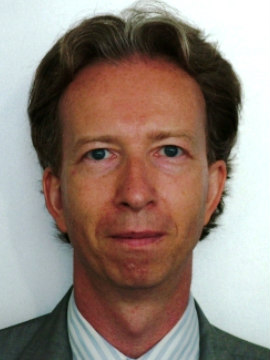
Ronan Lacroix is a Senior Expert Alliances & Business Development within the Technology Innovation division of the Deutsche Telekom Headquarters in Bonn, Germany. Besides the Management of DT’s strategic business alliances, he has been driving Open Innovation within the CTO organisation, working on the development of new business concepts and propositions based on innovative technologies and partners. In his role, he has been over the past 2 years evaluating and promoting the LiFi Technology as a complementary access technology to WiFi and Cellular networks in the wider context of 5G.
Previously, Ronan worked as a Global Product Manager within the Product & Innovation division of Deutsche Telekom, working with the GSMA community on the definition of cross-operator enabling products (APIs) for 3rd-parties based on Operator capabilities such as Identity, Payment or Messaging.
Before that, Ronan gathered extensive business and technical expertise holding various international and cross-functional management positions within major telecommunications and high-technology companies. Ronan received a Master’s Degree in Engineering in 1993 from the French “Ecole Nationale Supérieure des Télécommunications de Bretagne” with a specialisation in image processing and pattern recognition and is fluent in English, French and German.

Micheline Perrufel is Innovation Project Director at Orange Labs. 8 000 employees are now dedicated to Orange research and innovation. With 6,844 patents in its portfolio, Orange contributes to many cooperative projects, research partnerships with universities, laboratories or industry. Expert in the technologies of physical interactions, Micheline Perrufel works for the new LiFi technology, leads customer relationship projects for enterprises or at Home and anticipate the evolution of the Orange Boxes services. In her missions, Micheline Perrufel also exchanges with other telecom operators anticipating the next topics of innovation. Micheline's expertise is based on his training (ENST and ESSEC) as well as her professional experience. After leading technical teams working on Orange's core networks, Micheline helped launch the GSM mobile network in France. Passionate about wireless communications, Micheline is now encouraging the hybridization of radio, ultrasound and radio technologies to deliver more intelligent services.
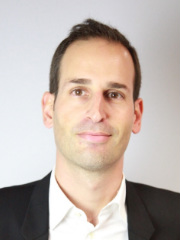
Sylvain Leroux is Customer Marketing Director for Datavenue an IoT program, and he is also Marketing Director for LiFi & Geolocation anticipation projects at Orange, one of the world’s leading telecommunications operators. Sylvain is an expert in digital transformation, change management and innovation (tech or usages): his focus is about to structure or manage game changing partners, ecosystems and services.
Sylvain is passionate about hybridization. He was previously building bridges between Physical and Digital worlds in the retail field. He has an extensive knowledge on opening new frontiers between Digital, Culture and Business: he has created with Erik Orsenna the first book award mixing professionals and internet users, gathering a community of 200K reading enthusiasts, and developed a Transmedia project with famous author Alexandre Jardin.
He has also worked for Africa, Middle East & Asia markets as Business Partner Communication where he mainly focused on Corporate Social Responsibility and Branding.

Simon Clement: Researching, trialling and implementing emerging technology. Working across multiple technologies with a focus on Network, Voice, Mobile and Television and interlacing new services through these basic service sets. Most recently focused on Wireless networking running high profile WiFi and LTE trials alongside TV White Space trials, LPWAN and LoRa trials and supporting use cases for Connected Cities.
Vendor experience in Network Design, Architecture, Software Engineering and Complex Integration for Class 4 and Class 5 switching technology in both Wireless and Wireline Carrier markets.
Implementation management for global deployments of switching architecture including work on all 5 continents. New product and new service development and programme management. Technical expertise in VoIP, TDM, Broadband, Carrier Data, WiFi and other wireless technology. Operating Company experience in product, deployment and technical architecture consultancy. Technical consultancy level expertise within VoIP and TDM Voice, Narrowband and Broadband Access Technologies, Mobile Voice and Data, Mobile TV, WiFi, LoRa, LPWAN and many other wireless technologies.
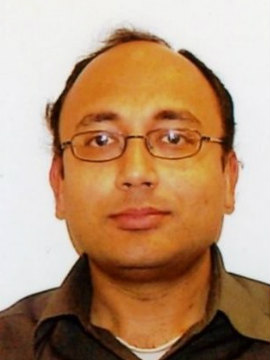
Nirlay Kundu is a Distinguished Engineer at Verizon Innovation Labs. He is currently managing Infrastructure Operations and Deployment in Verizon’s datacenters. Prior to this, Nirlay was involved in evaluating and choosing vendors for new technology, doing proof of concepts in the LTE EPC space. Prior to Verizon, Nirlay worked at Oracle, as a founding engineer at Rivermeadow Software, Motorola and Lucent. Nirlay holds several Advisory Board level positions. He has more than 20 years of expertise in the telco space and worked across several continents. He holds Bachelors and Masters degrees from Jadavpur University, IIT Kharagpur, Leicester University and MBA from Babson College. He is a frequent speaker and events related to telecommunications.

Dominique Chiaroni was born in Ajaccio, in April 27th, 1962. Graduated in Mechanics (IUT d’Aix-en-Provence), in Thermal sciences & Physics (Bachelor & Master at the University of Corsica), and in Optics and Microwaves (Engineer diploma obtained in 1990 from Institut National des Télécommunications), he was engaged in 1990 by Alcatel CIT to explore optical switching technologies and related systems and networks. Since 2000, he focused mainly his research on the design and the eco-design of energy efficient hybrid systems for different network segments from the core to the access network. Currently working in the IP and Optical Networks Lab within Nokia Bell Labs France, his focus is on low cost and low power consuming smart fabrics for 5G applications. He actively participated to several European and National projects and is currently the project leader of the French ANR N-GREEN project (2016-2018). Chair or co-chair of International Conference or Workshops he participates regularly to technical committees of many International Conferences. Distinguished member of the Alcatel-Lucent Technical Academy since 2003, Chapter Chair of the French Chapter from 2005 to 2013, he actively participated to the organisation of many events. He received more than ten internal and external awards. He authored and co-authored more than 200 publications and patents including contributions in books.
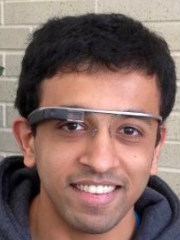
Gaurav Patwardhan was born in India on February 17, 1988. He received B. Eng. in Electronics from Pune University in 2011. After a brief stint in wireless security industry he graduated with high distinction in 2014 from North Carolina State University with a MSc. degree in Computer Networks specializing in wireless networks. Currently he works as a wireless protocol architect and a software test engineer in Aruba Networks (an HPE company). His technical interests include wireless communication technologies, network security and machine learning. He holds multiple patents and has co-authored paper in these fields. He also actively participates in the IEEE Standards Association procedures for evangelizing and ratifying new wireless technologies.
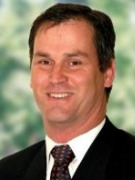
Dr Andrew Myles received his BSc in Computer Science & Pure Mathematics in 1985, and his BE in Electrical Engineering (First Class Honours & University Medal) in 1987, both from the University of Sydney in Australia. He received a PhD for his work on aspects of Mobile-IP and on a MAC suitable for operation with a 60Hz PHY from Macquarie University in Australia in 1996.
Dr Myles has had a diverse career, having worked in corporate research labs (Hewlett Packard Labs in the United Kingdom from 1987-1989, working on FDDI & DQDB systems and standards), university research labs (Macquarie Park Research from 1990-1994 in Sydney, working on SDMS systems, router architectures, Mobile IP and 60GHz wireless systems), management consulting and a technology start-up.
Dr Myles is currently the Manager of Enterprise Standards in the Chief Technology & Architecture Office at Cisco Systems.
Dr Myles has been a voting member of the IEEE 802.11 Working Group since 2001, and was the Editor of IEEE 802.11h (Spectrum Management to enable use of 802.11 5GHz systems in Europe) from 2001-2003. He became the Chair of the IEEE 802 JTC1 Standing Committee in 2009, which is the group coordinating activity between IEEE 802 and ISO/IEC JTC1/SC6. He has undertaken a similar role as the Head of Delegation of the US National Body delegation to ISO/IEC JTC1/SC6, and a participant of the corresponding US National Body Project 5 TAG.
He was a Director on the IEEE Standards Association Standards Board in 2015, and was appointed as a Governor on the IEEE Standards Association Board of Governors in 2016-17. Dr Myles has also promoted the use of IEEE 802.11 through his work in the Wi-Fi Alliance. He has been a Director of the Wi-Fi Alliance Board since 2003, was the Vice-Chair in 2006 and the Chair from 2006-2011. He briefly acted as the organisation’s Executive Director in 2007. He is currently the Chair of the Wi-Fi Alliance’s Liaison Committee and Secretary of the Board.
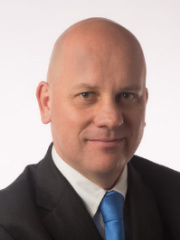
Christophe Jurczak: A graduate of Ecole Polytechnique and Ecole Normale Supérieure in France, Christophe Jurczak also holds a PhD in quantum physics from Ecole Polytechnique / Institut d'Optique. After starting at the French Ministry of Defense as a program manager in optronics, Christophe Jurczak has had a career in Europe and in the United States in the renewable energy sector. Based in Palo Alto, CA, he joined the LUCIBEL group in 2017 as Chief Scientific Officer in charge of Lucibel’s technology roadmap (LiFi, OCC and circadian lighting) and the development and implementation of new use cases that these technologies make possible. He is a member of the IEEE802.11 Light Communications Task Implementation Group and a LiFi evangelist.
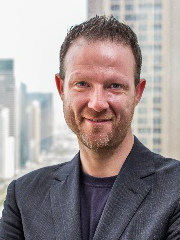
Marc Fleschen: Marc was an early advocate of technology and its application in both business and lifestyle environments. His combined passion for technology, together with his strategic business acumen and international network, make him the ideal leader for Zero.1.
A French native, Marc’s interest in international commerce started at an early age as he pursued his Bachelor's degree in Economics, (1996), and a Master's Degree in International Commerce (2000). A natural entrepreneur, Marc chose the fast-growing innovative city of Dubai as the base for his international operations when he established his company, JML Investment Group, in 2004. Less than three years later JML represented more than 32 European brands across 45 outlets, in the United Arab Emirates. The Group also operated an executive chartered airline company with a fleet of 24 planes, alongside several other retail, real estate and marketing businesses.

Marty Ragusky: In addition to working to extend the knowledge of LiFi technology to Government Agencies, technology developers, service providers, manufacturers, distributors and functional users throughout the world, Marty has an extensive background in C4ISR and intelligence data handling systems in capacities ranging from systems analyst through program manager and Vice President where he conducted requirements analysis and traceability, functional analyses, system/subsystem design & development (H/W & S/W), systems integration, test and evaluation, modeling and simulation, configuration management, risk management, and supportability engineering studies (feasibility, cost, and conformance). Additionally, Marty was a program manager for a number of critical wireless communication initiatives including: a complex wireless communications system (450/900MHz, 5/11/18GHz) that involved RF system design, link analyses, path analyses, scheduling, site surveys, pricing, logistics, managing multi-vendor quotes and developing teaming partnerships for a 130+ PTP-PTMP network throughout Prince William County VA; and, the design, installation and commissioning of a wireless network for a 150 acre campus at DC Water that consisted of more than 40 access points.
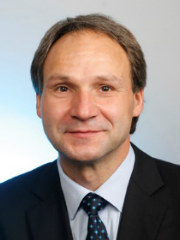
Volker Jungnickel (M’99) received doctoral and habilitation degrees in Physics and Communications Engineering from Humboldt University and Technical University in Berlin in 1995 and 2015, respectively. He joined Fraunhofer HHI in 1997 working on optical wireless communication, multiple antenna techniques in mobile networks and fixed access network technologies. Besides, he serves as Privatdozent at Technical University in Berlin where he gives lectures and supervises Bachelor, Masters and Ph.D. thesis. Currently, Volker serves as chair for IEEE P802.15.13 task group on “Multi-Gbit/s Optical Wireless Communication” and secretary for IEEE 802.11 study group on “Light Communications”.

Dimitri Kténas received the Dipl.-Ing. degree in Electrical Engineering from the Ecole Nationale Supérieure d’Electronique et de Radioélectricité (ENSERG), Grenoble (France), in 2001. From that time, he has been with CEA-Leti in Grenoble, France. His main current research interests are PHY, MAC and cross-layer optimization for both 5G cellular networks and LiFi systems. He has been involved in several European projects (4MORE, CODIV, ARTIST4G, EXALTED, iJOIN, 5GNOW, FANTASTIC-5G, mmMAGIC) and was the coordinator of the French OPUS project that dealt with LTE optimization. From 2010 to 2015, he was leading the Wireless Communication System Studies laboratory within CEA-Leti, which was in charge of baseband processing and MAC layer studies for wireless systems. In 2013, he launched the Visible Light Communication activities at CEA, first with internal funding from CEA-Leti, then with bilateral contracts with the French startup Luciom (2014-2016) that was acquired by Philips Lighting in December 2016. Since 2016, he was leading the Broadband Wireless Systems Lab within CEA-Leti, which is in charge of algorithm studies and HW/SW implementation of digital signal processing and protocols for both 5G and LiFi systems. In March 2018, he was appointed Department Head of Wireless Technologies (70+ persons), focusing on 5G, IoT and Optical Wireless Communication, from baseband to network layers including propagation modeling and antenna design. He has published 60+ scientific papers in international journals and conference proceedings and 5 book chapters, and is the main inventor or co-inventor of 13 patents.
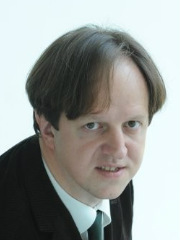
Harald Haas received the PhD degree from the University of Edinburgh in 2001. He currently holds the Chair of Mobile Communications at the University of Edinburgh, and is the founder and Chief Scientific Officer of pureLiFi Ltd as well as the Director of the LiFi Research and Development Center at the University of Edinburgh. His main research interests are in optical wireless communications, hybrid optical wireless and RF communications, spatial modulation, and interference management in wireless networks. He first introduced and coined ‘spatial modulation’ and ‘LiFi’. LiFi was listed among the 50 best inventions in TIME Magazine 2011. Prof. Haas was an invited speaker at TED Global 2011, and his talk: "Wireless Data from Every Light Bulb" has been watched online more than 2.4 million times. He gave a second TED Global talk in 2015 on the use of solar cells as LiFi data detectors and energy harvesters. This has been viewed online more than 2.0 million times. He has published more than 400 conference and journal papers including a paper in Science. He co-authors a book entitled: "Principles of LED Light Communications Towards Networked Li-Fi" published with Cambridge University Press in 2015. Prof. Haas is Associate Editor of the IEEE/OSA Journal of Lightwave Technologies. He was co-recipient of recent best paper awards at VTC-Fall, 2013, VTC-Spring 2015, ICC 2016, ICC 2017 and ICC 2018 He was co-recipient of the EURASIP Best Paper Award for the Journal on Wireless Communications and Networking in 2015, and co-recipient of the Jack Neubauer Memorial Award of the IEEE Vehicular Technology Society. In 2012 and 2017, he was the recipient of the prestigious Established Career Fellowship from the EPSRC (Engineering and Physical Sciences Research Council). In 2014, he was selected by EPSRC as one of ten RISE (Recognising Inspirational Scientists and Engineers) Leaders in the UK. In 2016, he received the outstanding achievement award from the International Solid State Lighting Alliance. He was elected a Fellow of the Royal Society of Edinburgh in 2017. Prof. Haas has been elevated to Fellow of the IEEE in 2017.
Editor: Paul Nikolich
Paul Nikolich has been serving the data communications and broadband industries developing technology, standards, intellectual property and establishing new ventures as an executive consultant and angel investor since 2001. He is an IEEE Fellow and has served as Chairman of the IEEE 802 LAN/MAN Standards Committee since 2001. As 802 Chairman he provides oversight for 75 active 802 standards and the 50+ concurrent 802 activities in wired and wireless communications networking. 802 has over 750 active members and manages relationships between IEEE 802 and global/regional standards bodies such as ISO, ITU, ETSI, regulatory bodies and industry alliances. He is a member of the IEEE Computer Society Standards Activities Board and active leader in the IEEE, the IEEE Computer Society and the IEEE Standards Association. He is a partner in YAS Broadband Friends LLC and holds several patents, serves on the boards of directors and technology advisory boards of companies developing emerging communications technology along with being a board member of the University of New Hampshire’s Broadband Center of Excellence. Mr. Nikolich has held technical leadership positions at large and small networking and technology companies (e.g., Broadband Access Systems, Racal-Datacom, Applitek, Motorola, Analogic). In 1978&79 he received a BS in Electrical Engineering, a BS in Biology and a M.S. in Biomedical Engineering from Polytechnic University in Brooklyn, N.Y (now the NYU Tandon School of Engineering).
Subscribe to Tech Focus
Join our IEEE Future Networks Technical Community and receive IEEE Future NetworksTech Focus delivered to your email.
Article Contributions Welcome
Submit Manuscript via Track Chair
Author guidelines can be found here.
Other Future Networks Publications
IEEE Future Networks Tech Focus Editorial Board
Rod Waterhouse, Editor-in-Chief
Mithun Mukherjee, Managing Editor
Imran Shafique Ansari
Anwer Al-Dulaimi
Stefano Buzzi
Yunlong Cai
Zhi Ning Chen
Panagiotis Demestichas
Ashutosh Dutta
Yang Hao
Gerry Hayes
Chih-Lin I
James Irvine
Meng Lu
Amine Maaref
Thas Nirmalathas
Sen Wang
Shugong Xu
Haijun Zhang
Glaucio Haroldo Silva de Carvalho

